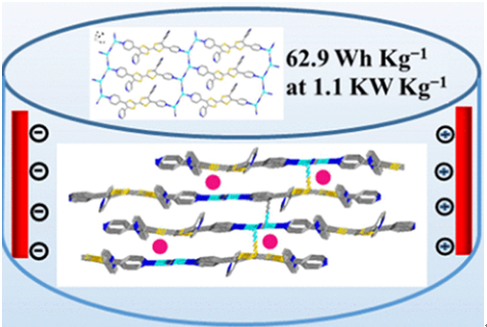欢迎进入,正规beat365旧版_365bet开户网站_best365网页版登录材料与化学化工学部
Redox-Active Two-Dimensional Tetrathiafulvalene-Copper Metal−Organic Framework with Boosted Electrochemical Performances for Supercapatteries
Zhi-Ruo Zhang, Zhou-Hong Ren, Chen-Yue Luo, Li-Jun Ma, Jie Dai, and Qin-Yu Zhu*(朱琴玉)
College of Chemistry, Chemical Engineering and Materials Science, Soochow University, Suzhou 215123, P. R. China
Inorg. Chem.2023, 62, 4672--4679
Metal–organic frameworks (MOFs) have attracted noticeable attention as promising candidates for electrochemical energy storage. However, the lack of electrical conductivity and the weak stability of most MOFs result in poor electrochemical performances. Here, a tetrathiafulvalene (TTF)-based complex, formulated as [(CuCN)2(TTF(py)4)] (1) (TTF-(py)4 = tetra(4-pyridyl)-TTF), is assembled by in situ generation of coordinated CN– from a nontoxic source. Single-crystal X-ray diffraction analysis reveals that compound 1 possesses a two-dimensional layered planar structure, which is further stacked in parallel to form a three-dimensional supramolecular framework. The planar coordination environment of 1 is the first example of a TTF-based MOF. Attributed to the unique structure and redox TTF ligand, the electrical conductivity of 1 is significantly increased by 5 orders of magnitude upon iodine treatment. The iodine-treated 1 (1-ox) electrode displays typical battery-type behavior through electrochemical characterizations. The supercapattery based on the 1-ox positrode and AC negatrode presents a high specific capacity of 266.5 C g–1 at a specific current of 1 A g–1 with a remarkable specific energy of 62.9 Wh kg–1 at a specific power of 1.1 kW kg–1. The excellent electrochemical performance of 1-ox is one of the best among those reported supercapatteries, demonstrating a new strategy for developing MOF-based electrode materials.
